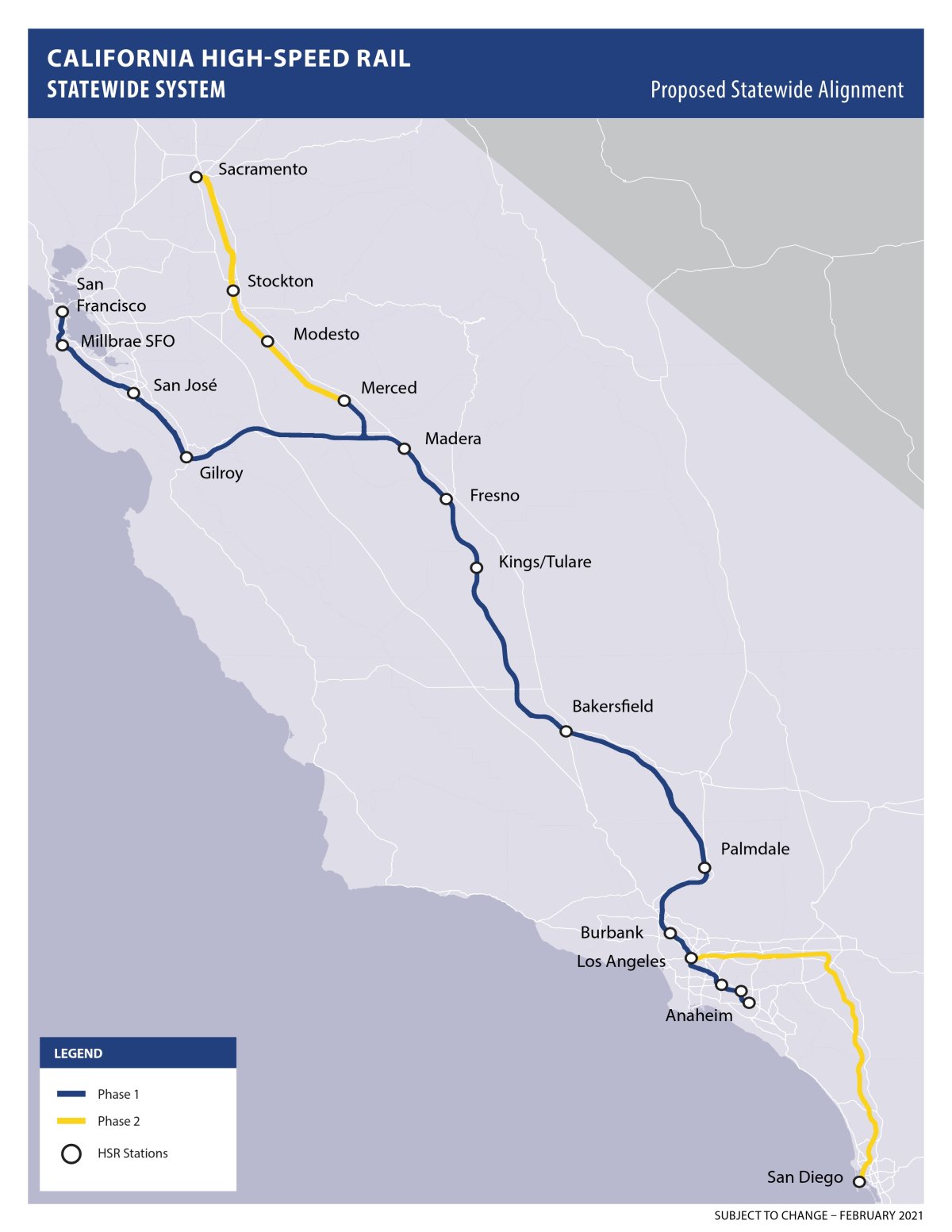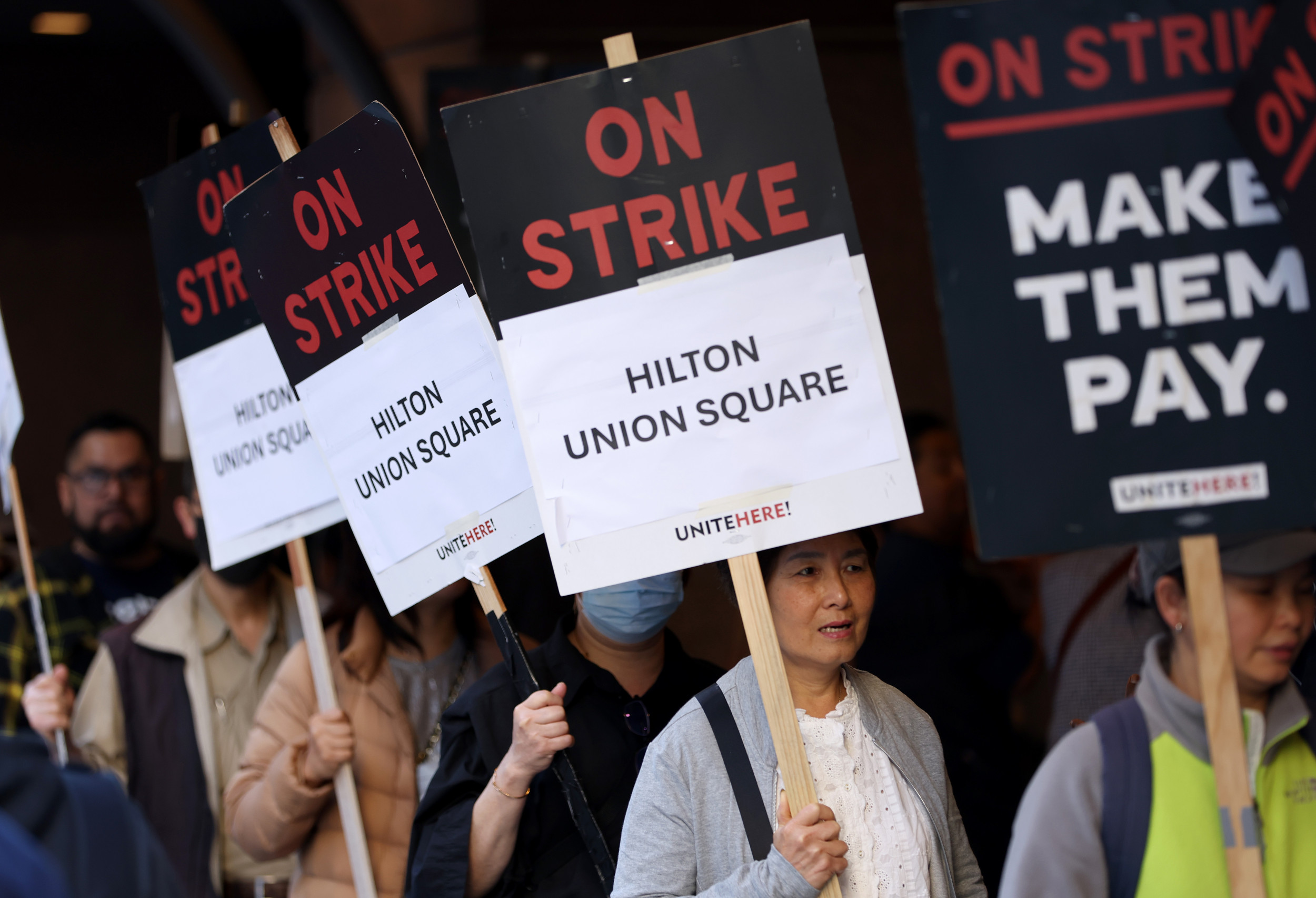California
Hurricane Hilary threatens ‘catastrophic and life-threatening’ flooding in Mexico and California

CABO SAN LUCAS, Mexico (AP) — Hurricane Hilary headed for Mexico’s Baja California Saturday as the U.S, National Hurricane Center predicted “catastrophic and life-threatening flooding” for the peninsula and for the southwestern United States, where it is forecast to make land as a tropical storm on Sunday.
Officials as far north as Los Angeles scrambled to get the homeless off the streets, set up shelters and prepare for evacuations.
Hilary is expected to plow into the Mexican peninsula on Saturday night and then surge northward and enter the history books as the first tropical storm to hit Southern California in 84 years.
The U.S. National Hurricane Center issued a tropical storm watch for a wide swath of Southern California from the Pacific coast to interior mountains and deserts. Officials talked of evacuation plans for California’s Catalina Island.
“I don’t think any of us — I know me particularly — never thought I’d be standing here talking about a hurricane or a tropical storm,” said Janice Hahn, chair of the Los Angeles County Board of Supervisors.
After rapidly gaining power early Friday, Hilary slowed some later in the day but remained a major Category 4 hurricane early Saturday with maximum sustained winds of 130 mph (215 kph), down from 145 mph (230 kph).
Early Saturday, the storm was centered about 260 miles (415 kilometers) west-southwest of the southern tip of the Baja peninsula. It was moving north-northwest at 13 mph (20 kph) and was expected to turn more toward the north and pick up speed.
The latest forecast track pointed to Hilary making landfall along a sparsely populated area of the Baja peninsula at a point about 200 miles (330 kilometers) south of the Pacific port city of Ensenada.
It is then expected to continue northward, raising fears that its heavy rains could cause dangerous flooding in the border city of Tijuana, where many homes in the city of 1.9 million cling precariously to steep hillsides.
Mayor Montserrat Caballero Ramirez said the city was setting up four shelters in high-risk zones and warning people in risky zones.
“We are a vulnerable city being on one of the most visited borders in the world and because of our landscape,” she said.
Concern was rising in the U.S., too.
The National Park Service closed Joshua Tree National Park and Mojave National Preserve to keep people from becoming stranded amid flooding. Cities across the region, including in Arizona, were offering sandbags to safeguard properties against floodwaters. Major League Baseball rescheduled three Sunday games in Southern California, moving them to Saturday as part of split-doubleheaders,
Deputies with the Los Angeles Sheriff’s Department took to the road to urge homeless people living in riverbeds to seek shelter. Authorities in the city were arranging food, cots and shelters for people who needed them.
SpaceX delayed the launch of a satellite-carrying rocket from a base on California’s central coast until at least Monday. The company said conditions in the Pacific could make it difficult for a ship to recover the rocket booster.
President Joe Biden said the Federal Emergency Management Agency had pre-positioned staff and supplies in the region.
“I urge everyone, everyone in the path of this storm, to take precautions and listen to the guidance of state and local officials,” Biden told reporters Friday at Camp David, where he is meeting with the leaders of Japan and South Korea.
Officials in Southern California were re-enforcing sand berms, built to protect low-lying coastal communities against winter surf, like in Huntington Beach, which dubs itself as “Surf City USA.”
In nearby Newport Beach, Tanner Atkinson waited in a line of vehicles for free sandbags at a city distribution point.
“I mean a lot of people here are excited because the waves are gonna get pretty heavy,” Atkinson said. “But I mean, it’s gonna be some rain, so usually there’s some flooding and the landslides and things like that.”
Some schools in Cabo San Lucas were being prepared as temporary shelters, and in La Paz, the picturesque capital of Baja California Sur state on the Sea of Cortez, police patrolled closed beaches to keep swimmers out of the whipped-up surf. Schools were shut down in five municipalities.
It was increasingly likely that Hilary would reach California on Sunday while still at tropical storm strength, though widespread rain was expected to begin as early as Saturday, the National Weather Service’s San Diego office said.
Hurricane officials said the storm could bring heavy rainfall to the southwestern United States, dumping 3 to 6 inches (8 to 15 centimeters) in places, with isolated amounts of up to 10 inches (25 centimeters), in portions of southern California and southern Nevada.
“Two to three inches of rainfall in Southern California is unheard of” for this time of year, said Kristen Corbosiero, a University of Albany atmospheric scientist who specializes in Pacific hurricanes. “That’s a that’s a whole summer and fall amount of rain coming in probably 6 to 12 hours.”
The region could face once-in-a-century rains and there is a good chance Nevada will break its all-time rainfall record, said meteorologist Jeff Masters of Yale Climate Connections and a former government in-flight hurricane meteorologist.
___
Watson reported from San Diego. Associated Press writers Seth Borenstein in Washington, Maria Verza and Mark Stevenson in Mexico City, John Antczak in Los Angeles, and Eugene Garcia in Newport Beach, California, contributed to this report.

California
California Roots Threaten JuJu Watkins’ NCAA Road to Rivaling Caitlin Clark

Ever since Caitlin Clark left the NCAA to set records in the WNBA, the hunt for the next generational basketball talent has intensified. Among the emerging stars, JuJu Watkins stands out with her electrifying performances for USC and record-breaking milestones. But while her game dazzles on the court, her California roots and unique circumstances create hurdles that may hinder her quest to rival Clark’s legendary NCAA career.
On the latest episode of Fearless with Jason Whitlock, Whitlock tackled the issue, highlighting the contrasting environments between Clark’s Iowa and Watkins’ Los Angeles.
“Well, Caitlin Clark was in Iowa in the middle of nowhere. She wasn’t in the entertainment capital of the world. She wasn’t in a city that had 75-degree weather year-round and open beaches. She went off or she grew up in and continued to play in a little isolated area of the country where people are starved for entertainment. And so she built a huge following right there in the state of Iowa, her home state,” he said.
ADVERTISEMENT
Article continues below this ad
The deeper issue, according to Whitlock, is the cultural and entertainment saturation of Los Angeles, where sports often compete with numerous distractions for attention. In contrast, Clark thrived in a basketball-centric environment, with little competition for local and statewide support. While Watkins’ environment may pose unique challenges, her talent remains undeniable.
She recently made history as the fastest Power Five player in women’s college basketball to reach 1,000 career points, accomplishing the feat in just 38 games—two fewer than Clark’s record. With season averages of 24.8 points, 5.8 rebounds, and 3.8 assists on 46.2% shooting, Watkins is unquestionably a dominant force. Yet, as Jason Whitlock put it, the question persists: Can she cultivate the same level of national adoration that Clark commanded?
Balancing brilliance: Can JuJu Watkins thrive amid criticism and California’s spotlight?
ADVERTISEMENT
Article continues below this ad
Adding to the debate, Rachel DeMita voiced concerns over how USC is managing Watkins’ playing time on her own podcast. “I don’t think that’s what JuJu needs for the development of her game,” DeMita said, suggesting that keeping Watkins on the court for extended minutes might be more about stat-padding than fostering her growth as a player.
via Imago
Dec 21, 2024; Hartford, Connecticut, USA; USC Trojans guard JuJu Watkins (12) drives the ball agains UConn Huskies guard Paige Bueckers (5) and guard Kaitlyn Chen (20) in the second half at XL Center. Mandatory Credit: David Butler II-Imagn Images
Such a strategy could also increase her risk of injury, a significant concern given Watkins’ pivotal role for USC.
ADVERTISEMENT
Article continues below this ad
Despite these challenges, Watkins has demonstrated resilience and poise. Her performance this season reflects her ability to adapt and excel under pressure. However, her journey to rival Caitlin Clark’s legacy will require more than individual brilliance. Watkins must navigate the complexities of playing in a city where attention is fragmented, balancing her development with the need to draw a larger following.
Whether she can carve out her own path and emerge as a player of Clark’s stature remains uncertain. For now, her record-breaking performances and undeniable talent keep her firmly in the conversation, as the basketball world watches to see if she can overcome the challenges of her California roots and fulfill her potential as the next NCAA superstar.
California
Lights back on after power outage in parts of Southern California

Watch CBS News
Be the first to know
Get browser notifications for breaking news, live events, and exclusive reporting.
California
How California’s high-speed rail line will advance in 2025

California’s high-speed rail project, which aims to connect San Francisco and Los Angeles with a 494-mile route capable of speeds up to 220 mph, aims to continue construction in 2025.
Phase 1 of the project focuses on linking San Francisco in the north to Anaheim via Los Angeles in the south, with plans to extend the line north to Sacramento and south to San Diego in Phase 2.
The California High-Speed Rail Authority, which is overseeing the project says it has already generated significant economic benefits, including creating over 14,000 construction jobs and involving 875 small businesses.
But despite its transformative goals, the project remains politically contentious, with critics questioning its costs and viability. It has been in development since voters approved funding in 2008 and has faced delays, cost increases, and shifting timelines.
Photo Illustration by Newsweek
Work Planned for 2025
In a statement to Newsweek, the California High-Speed Rail Authority outlined its planned work for 2025, which focuses on continuing construction in the Central Valley between Merced and Bakersfield.
The 171-mile segment between Merced and Bakersfield will be the first part of the line to be operational, with services expected to start between 2030 and 2033. Of that section, 119 miles are currently under construction.
Of the planned structures in the Central Valley section, 85 are underway or completed out a total of 93 on the segment. Work will continue on these structures as well as on the tracks capable of handling high-speed trains.
By the end of 2025, civil construction on the 119-mile segment currently underway is expected to be completed and construction will begin on the next stretches to Merced and Bakersfield.
In 2025, the authority also plans to advance design and begin construction on its stations in the Central Valley. It also expects to select a manufacturer for the trains.
Although the initial operating segment will only run 171 miles from Merced to Bakersfield, environmental clearances have been obtained for 463 miles of the 494-mile Phase 1 route, completing the stretch between San Francisco and Los Angeles. Only the Los Angeles-to-Anaheim section is still awaiting approval.

California High Speed Rail Authority
The Authority said it plans to publish its draft environmental impact report for the Los Angeles-to-Anaheim section in 2025, a key milestone for the eventual full-approval of Phase 1.
More than $11 billion has been invested to date, with funding sources including state bonds, federal grants, and proceeds from California’s carbon emission trading auctions.
The authority has not yet received funding to construct the segments westwards from the Central Valley to the Bay Area or southwards to Los Angeles.
Despite this, the authority said it was committed to pushing on.
“California is the first in the nation to build a true high-speed rail system with speeds capable of reaching 220 mph,” the Authority told Newsweek. “The Authority remains committed and aggressive in moving this historic project forward while actively pursuing additional funding.”
Political Opposition to the Project
Despite ongoing progress, the high-speed rail project continues to face political opposition, particularly from Republican leaders.
While President Joe Biden’s administration has invested billions in it since 2021, the incoming Republican administration, which will control the House of Representatives, the Senate, and the presidency, is unlikely to continue funding it at the same level.
Representative Sam Graves of Missouri, who chairs the House Transportation and Infrastructure Committee, has criticized the project’s costs and funding strategies.
In a statement to Newsweek, Graves described the rail line as a “highly troubled project” and raised concerns about its reliance on government subsidies.

California High Speed Rail Authority
He pointed out that the current funding supports only a limited segment between Merced and Bakersfield, which he estimated will cost $35 billion.
“Full cost estimates [for Phase 1, between San Francisco and Anaheim] now exceed $100 billion and growing,” Graves said, calling for a comprehensive review of the project before any additional funding is allocated.
“California high-speed rail must have a plan and prove that it can wisely and responsibly spend government money—something it’s failed to do so far.”
The congressman stated that over the next four years, he would oppose any further federal funding for the California high-speed rail project.
Instead, Graves advocated for efforts to redirect unspent funds and focus on improving existing transportation infrastructure, such as Amtrak.
Graves also emphasized the need for private-sector involvement in future rail projects, citing Brightline’s operations in Florida and Las Vegas as a successful example of private investment.
While Graves acknowledged the potential of high-speed rail, he argued that the California project has failed to meet the necessary criteria for viability and local demand.
The authority told Newsweek it would engage with the federal government to seek other funding sources.
“We continue to explore strategies aimed at stabilizing funding, potentially allowing the program to draw private financing and/or government loans,” it said.
-
/cdn.vox-cdn.com/uploads/chorus_asset/file/24924653/236780_Google_AntiTrust_Trial_Custom_Art_CVirginia__0003_1.png)
/cdn.vox-cdn.com/uploads/chorus_asset/file/24924653/236780_Google_AntiTrust_Trial_Custom_Art_CVirginia__0003_1.png) Technology5 days ago
Technology5 days agoGoogle’s counteroffer to the government trying to break it up is unbundling Android apps
-

 News6 days ago
News6 days agoNovo Nordisk shares tumble as weight-loss drug trial data disappoints
-

 Politics6 days ago
Politics6 days agoIllegal immigrant sexually abused child in the U.S. after being removed from the country five times
-

 Entertainment7 days ago
Entertainment7 days ago'It's a little holiday gift': Inside the Weeknd's free Santa Monica show for his biggest fans
-

 Lifestyle6 days ago
Lifestyle6 days agoThink you can't dance? Get up and try these tips in our comic. We dare you!
-

 Technology1 week ago
Technology1 week agoFox News AI Newsletter: OpenAI responds to Elon Musk's lawsuit
-
/cdn.vox-cdn.com/uploads/chorus_asset/file/25672934/Metaphor_Key_Art_Horizontal.png)
/cdn.vox-cdn.com/uploads/chorus_asset/file/25672934/Metaphor_Key_Art_Horizontal.png) Technology2 days ago
Technology2 days agoThere’s a reason Metaphor: ReFantanzio’s battle music sounds as cool as it does
-

 News3 days ago
News3 days agoFrance’s new premier selects Eric Lombard as finance minister



















